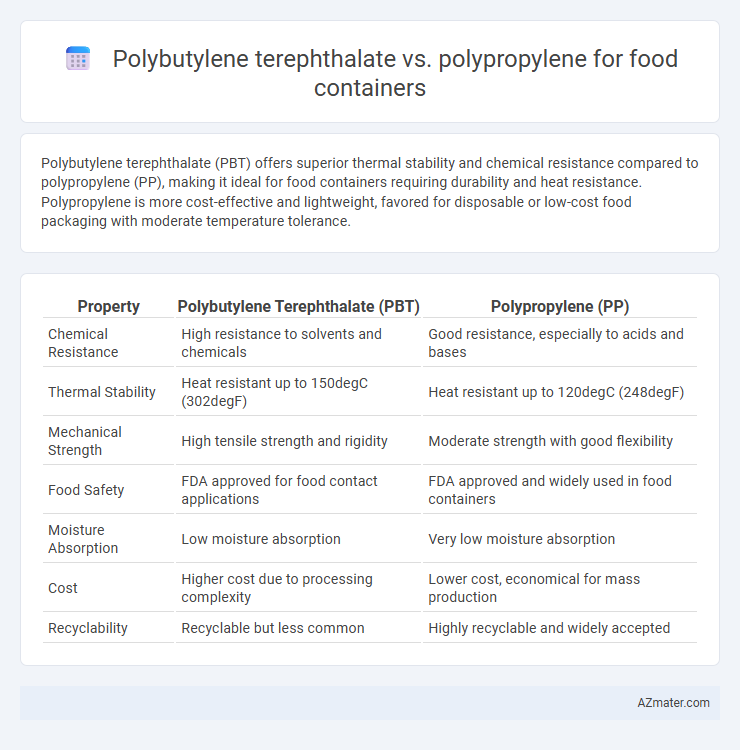Polybutylene terephthalate (PBT) offers superior thermal stability and chemical resistance compared to polypropylene (PP), making it ideal for food containers requiring durability and heat resistance. Polypropylene is more cost-effective and lightweight, favored for disposable or low-cost food packaging with moderate temperature tolerance.
Table of Comparison
| Property | Polybutylene Terephthalate (PBT) | Polypropylene (PP) |
|---|---|---|
| Chemical Resistance | High resistance to solvents and chemicals | Good resistance, especially to acids and bases |
| Thermal Stability | Heat resistant up to 150degC (302degF) | Heat resistant up to 120degC (248degF) |
| Mechanical Strength | High tensile strength and rigidity | Moderate strength with good flexibility |
| Food Safety | FDA approved for food contact applications | FDA approved and widely used in food containers |
| Moisture Absorption | Low moisture absorption | Very low moisture absorption |
| Cost | Higher cost due to processing complexity | Lower cost, economical for mass production |
| Recyclability | Recyclable but less common | Highly recyclable and widely accepted |
Introduction to Polybutylene Terephthalate (PBT) and Polypropylene (PP)
Polybutylene terephthalate (PBT) is a thermoplastic polyester known for its high mechanical strength, excellent chemical resistance, and dimensional stability, making it suitable for durable food containers. Polypropylene (PP) is a widely used thermoplastic polymer favored for its low density, excellent moisture resistance, and cost-effectiveness, commonly chosen for lightweight and disposable food packaging. Both materials offer food safety compliance but differ in thermal resistance and rigidity, influencing their application in various types of food containers.
Chemical Structures and Properties Comparison
Polybutylene terephthalate (PBT) features an aromatic polyester backbone with ester linkages providing high thermal stability and chemical resistance, making it suitable for food containers exposed to heat and aggressive cleaning agents. Polypropylene (PP) consists of a saturated hydrocarbon polymer chain with methyl side groups, offering excellent chemical inertness, lightweight properties, and good fatigue resistance but lower thermal resistance compared to PBT. The rigid, crystalline structure of PBT enhances dimensional stability and mechanical strength, whereas PP's semi-crystalline nature ensures flexibility and cost-effectiveness for disposable or low-heat food storage applications.
Mechanical Strength: PBT vs Polypropylene
Polybutylene terephthalate (PBT) exhibits superior mechanical strength compared to polypropylene (PP), making it more resistant to impact and deformation under stress. PBT's higher tensile strength and rigidity contribute to better durability and shape retention in food containers subjected to heavy loads or frequent handling. Polypropylene, although flexible and lightweight, tends to have lower tensile strength and can deform more easily under mechanical strain.
Thermal Resistance and Temperature Tolerance
Polybutylene terephthalate (PBT) offers superior thermal resistance compared to polypropylene (PP), maintaining structural integrity at temperatures up to 150degC, making it ideal for high-heat food containers. Polypropylene, with a melting point around 160degC, provides good temperature tolerance but is more prone to deformation at temperatures above 100degC during prolonged exposure. PBT's enhanced dimensional stability and heat resistance make it preferable for food containers subjected to repeated microwaving or hot filling processes.
Food Safety and Regulatory Compliance
Polybutylene terephthalate (PBT) offers superior heat resistance and dimensional stability, making it highly compliant with FDA and EFSA regulations for food contact materials, ensuring safety against chemical migration. Polypropylene (PP), widely used for food containers, complies with food safety standards due to its inert nature and ability to withstand repeated refrigeration and microwaving without leaching harmful substances. Both polymers are BPA-free and meet global regulatory requirements, but PBT's enhanced thermal properties provide added assurance in applications involving higher temperatures or sterilization processes.
Barrier Properties: Oxygen and Moisture Resistance
Polybutylene terephthalate (PBT) exhibits superior oxygen barrier properties compared to polypropylene (PP), making it more effective in preserving food freshness by reducing oxygen permeability. PBT also offers enhanced moisture resistance, which helps maintain the integrity and shelf life of food products by preventing moisture ingress. While polypropylene is widely used for food containers due to its cost-effectiveness and flexibility, PBT's improved barrier properties make it a better choice for applications requiring higher protection against oxygen and moisture.
Durability and Long-Term Performance
Polybutylene terephthalate (PBT) exhibits superior durability compared to polypropylene (PP) in food container applications, offering enhanced resistance to impact, heat, and chemical degradation. PBT's long-term performance is marked by excellent dimensional stability and resistance to repeated sterilization, making it ideal for containers exposed to high temperatures and rigorous washing. In contrast, polypropylene, while lightweight and cost-effective, tends to exhibit reduced mechanical strength and may degrade faster under prolonged heat exposure, limiting its lifespan in demanding food storage environments.
Cost Analysis for Food Packaging Applications
Polybutylene terephthalate (PBT) typically incurs higher material costs compared to polypropylene (PP) due to its superior thermal and chemical resistance properties, which enhance durability in food packaging applications. Polypropylene remains more cost-effective with lower raw material expenses and simpler processing techniques, making it a preferred choice for high-volume, low-cost food containers. The decision between PBT and PP hinges on balancing upfront cost with long-term performance requirements and regulatory compliance in food safety.
Environmental Impact and Recyclability
Polybutylene terephthalate (PBT) offers superior thermal stability and chemical resistance compared to polypropylene (PP), making it more durable for food containers but with a higher environmental footprint due to energy-intensive production. Polypropylene is widely favored for its lower carbon emissions and easier recyclability in municipal recycling systems, contributing to reduced environmental impact. Both materials are recyclable; however, PP recycling infrastructure is more established, enhancing its sustainability profile for disposable and reusable food packaging.
Conclusion: Best Choice for Food Containers
Polypropylene outperforms Polybutylene terephthalate for food containers due to its excellent chemical resistance, high melt temperature, and superior flexibility, ensuring safety and durability during repeated use and washing. PBT offers good mechanical strength and dimensional stability but is less resistant to prolonged exposure to moisture and certain food acids, which may compromise container lifespan. Considering food safety regulations and practical performance, polypropylene remains the best choice for reliable, reusable food containers.

Infographic: Polybutylene terephthalate vs Polypropylene for Food container
 azmater.com
azmater.com